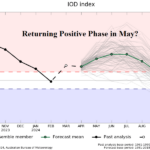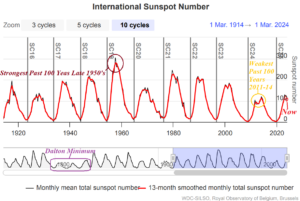
Cloud Cover Forecast for April 8 Eclipse Update
04/07/2024, 9:45 am EDT
Australia Winter Climate Conflict Regarding Indian Ocean Dipole
04/09/2024, 4:42 am EDT
Fig. 1: The sunspot number for March 2024 surprisingly decreased sharply to 104.9 after a peak of 160 last July as onset of solar cycle 25 maxima began. The weak solar cycle 25 prediction by NASA now seems on track.
Discussion: During March 2024, the sunspot number (SSN) was 104.9. The monthly value is surprisingly decreasing. The peak monthly SSN value as solar cycle 25 began maxima last year was 160 in July 2023. Because of the over-achieving sunspot number early in solar maxima 25, some forecasts were adjusted to produce record-strength maxima forecasts during solar cycle peak in 2025. However, the NASA forecast, which mirrored the solar cycle 24 signature appears to be on track with the sudden sharp decrease in SSN during March.
Historically, Solar Cycle 25 appears to be similar with the previous, with potential for a double peak and each crest somewhat lower than recent solar cycle maxima’s dating back to 1980. Note that the last decadal inactive period of the sun occurred during the early 1800’s known as the Dalton Minimum. After the low energy solar cycle 24, some scientists proposed that another Dalton Minimum-like period may be underway. However, the over-achieving SSN early in solar maxima 25 seemed to dispel that possibility. Months later, the relatively inactive solar maxima forecast by NASA is now on track!

Fig. 2: The suddenly weaker solar cycle 25 maxima, appears similar with previous maxima. A concern we’re entering a decadal period of a relatively inactive sum is renewed.
![Climate-Impact-Company-logo-sm[1]](https://climateimpactcompany.com/wp-content/uploads/2023/08/Climate-Impact-Company-logo-sm1.png)
